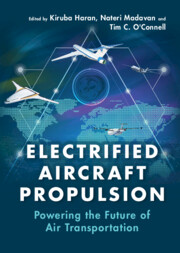Book contents
- Electrified Aircraft Propulsion
- Electrified Aircraft Propulsion
- Copyright page
- Dedication
- Contents
- Contributors
- Preface
- 1 Benefits of Electrified Propulsion for Large Aircraft
- 2 Aircraft Electric Power System Design, Control, and Protection
- 3 Megawatt-Scale Electric Machines for Electrified Aircraft Propulsion
- 4 Superconducting Machines and Cables
- 5 Conventional Power Electronics for Electrified Aircraft Propulsion
- 6 Cryogenic Power Electronics
- 7 Electrochemical Energy Storage and Conversion for Electrified Aircraft
- 8 Thermal Management of Electrified Propulsion Systems
- 9 Performance Assessment of Electrified Aircraft
- Index
- References
5 - Conventional Power Electronics for Electrified Aircraft Propulsion
Published online by Cambridge University Press: 11 May 2022
- Electrified Aircraft Propulsion
- Electrified Aircraft Propulsion
- Copyright page
- Dedication
- Contents
- Contributors
- Preface
- 1 Benefits of Electrified Propulsion for Large Aircraft
- 2 Aircraft Electric Power System Design, Control, and Protection
- 3 Megawatt-Scale Electric Machines for Electrified Aircraft Propulsion
- 4 Superconducting Machines and Cables
- 5 Conventional Power Electronics for Electrified Aircraft Propulsion
- 6 Cryogenic Power Electronics
- 7 Electrochemical Energy Storage and Conversion for Electrified Aircraft
- 8 Thermal Management of Electrified Propulsion Systems
- 9 Performance Assessment of Electrified Aircraft
- Index
- References
Summary
Power electronic circuits enable electrified aircraft propulsion (EAP) – from the More-Electric Aircraft (MEA) (an aircraft where the propulsion systems are still traditional, but some or all of the secondary non-propulsion-related subsystems are electrified) to the All-Electric Aircraft (AEA) (an aircraft with fully electrified propulsion and secondary subsystems) – and their importance cannot be understated. This chapter provides general power conversion concepts while fostering a solid high-level understanding of power electronic circuits, focusing on those circuits and devices that are crucial for EAP. Power system metrics, including power density and voltage, and integration techniques are presented. This is followed by a description of relevant converter topologies, including two- and multi-level inverters, direct and indirect matrix converters, rectifiers, circuits for open winding and multi-phase electric machines, and fault-tolerant topologies. A discussion of semiconductor devices and materials, including a brief discussion of silicon-carbide (SiC) devices, concludes the chapter.
Keywords
- Type
- Chapter
- Information
- Electrified Aircraft PropulsionPowering the Future of Air Transportation, pp. 130 - 149Publisher: Cambridge University PressPrint publication year: 2022



